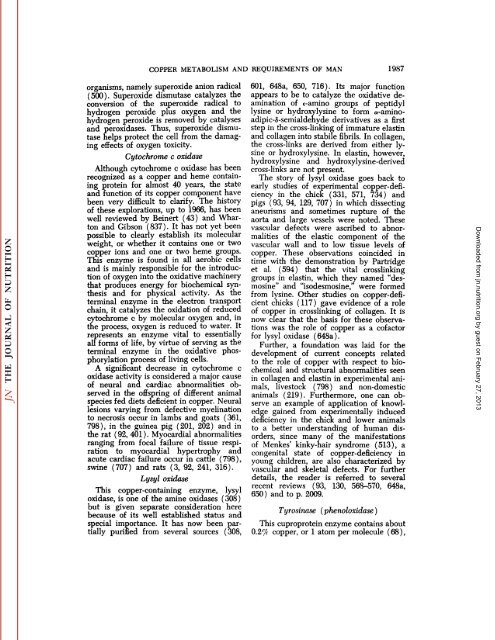conspectus of researchon copper metabolism and requirements
conspectus of researchon copper metabolism and requirements
conspectus of researchon copper metabolism and requirements
Create successful ePaper yourself
Turn your PDF publications into a flip-book with our unique Google optimized e-Paper software.
COPPER METABOLISM AND REQUIREMENTS OF MAN 1987<br />
organisms, namely Superoxide aniónradical<br />
(500). Superoxide dismutase catalyzes the<br />
conversion <strong>of</strong> the Superoxide radical to<br />
hydrogen peroxide plus oxygen <strong>and</strong> the<br />
hydrogen peroxide is removed by catalyses<br />
<strong>and</strong> peroxidases. Thus, Superoxide dismu<br />
tase helps protect the cell from the damag<br />
ing effects <strong>of</strong> oxygen toxicity.<br />
Cytochrome c oxidase<br />
Although cytochrome c oxidase has been<br />
recognized as a <strong>copper</strong> <strong>and</strong> heme contain<br />
ing protein for almost 40 years, the state<br />
<strong>and</strong> function <strong>of</strong> its <strong>copper</strong> component have<br />
been very difficult to clarify. The history<br />
<strong>of</strong> these explorations, up to 1966, has been<br />
well reviewed by Beinert (43) <strong>and</strong> Wharton<br />
<strong>and</strong> Gibson (837). It has not yet been<br />
possible to clearly establish its molecular<br />
weight, or whether it contains one or two<br />
<strong>copper</strong> ions <strong>and</strong> one or two heme groups.<br />
This enzyme is found in all aerobic cells<br />
<strong>and</strong> is mainly responsible for the introduc<br />
tion <strong>of</strong> oxygen into the oxidative machinery<br />
that produces energy for biochemical syn<br />
thesis <strong>and</strong> for physical activity. As the<br />
terminal enzyme in the electron transport<br />
chain, it catalyzes the oxidation <strong>of</strong> reduced<br />
cytochrome c by molecular oxygen <strong>and</strong>, in<br />
the process, oxygen is reduced to water. It<br />
represents an enzyme vital to essentially<br />
all forms <strong>of</strong> life, by virtue <strong>of</strong> serving as the<br />
terminal enzyme in the oxidative phosphorylation<br />
process <strong>of</strong> living cells.<br />
A significant decrease in cytochrome c<br />
oxidase activity is considered a major cause<br />
<strong>of</strong> neural <strong>and</strong> cardiac abnormalities ob<br />
served in the <strong>of</strong>fspring <strong>of</strong> different animal<br />
species fed diets deficient in <strong>copper</strong>. Neural<br />
lesions varying from defective myelination<br />
to necrosis occur in lambs <strong>and</strong> goats (361,<br />
798), in the guinea pig (201, 202) <strong>and</strong> in<br />
the rat (92, 401 ). Myocardial abnormalities<br />
ranging from focal failure <strong>of</strong> tissue respi<br />
ration to myocardial hypertrophy <strong>and</strong><br />
acute cardiac failure occur in cattle (798),<br />
swine (707) <strong>and</strong> rats (3, 92, 241, 316).<br />
Lysyl oxidase<br />
This <strong>copper</strong>-containing enzyme, lysyl<br />
oxidase, is one <strong>of</strong> the amine oxidases (308 )<br />
but is given separate consideration here<br />
because <strong>of</strong> its well established status <strong>and</strong><br />
special importance. It has now been par<br />
tially purified from several sources (308,<br />
601, 648a, 650, 716). Its major function<br />
appears to be to catalyze the oxidative deamination<br />
<strong>of</strong> e-amino groups <strong>of</strong> peptidyl<br />
lysine or hydroxylysine to form «-aminoadipic-S-semialdehyde<br />
derivatives as a first<br />
step in the cross-linking <strong>of</strong> immature elastin<br />
<strong>and</strong> collagen into stabile fibrils. In collagen,<br />
the cross-links are derived from either ly<br />
sine or hydroxylysine. In elastin, however,<br />
hydroxylysine <strong>and</strong> hydroxylysine-derived<br />
cross-links are not present.<br />
The story <strong>of</strong> lysyl oxidase goes back to<br />
early studies <strong>of</strong> experimental <strong>copper</strong>-defi<br />
ciency in the chick (331, 571, 734) <strong>and</strong><br />
pigs (93, 94, 129, 707) in which dissecting<br />
aneurisms <strong>and</strong> sometimes rupture <strong>of</strong> the<br />
aorta <strong>and</strong> large vessels were noted. These<br />
vascular defects were ascribed to abnor<br />
malities <strong>of</strong> the elastic component <strong>of</strong> the<br />
vascular wall <strong>and</strong> to low tissue levels <strong>of</strong><br />
<strong>copper</strong>. These observations coincided in<br />
time with the demonstration by Partridge<br />
et al. (594) that the vital crosslinking<br />
groups in elastin, which they named "desmosine"<br />
<strong>and</strong> "isodesmosine," were formed<br />
from lysine. Other studies on <strong>copper</strong>-defi<br />
cient chicks (117) gave evidence <strong>of</strong> a role<br />
<strong>of</strong> <strong>copper</strong> in crosslinking <strong>of</strong> collagen. It is<br />
now clear that the basis for these observa<br />
tions was the role <strong>of</strong> <strong>copper</strong> as a c<strong>of</strong>actor<br />
for lysyl oxidase (648a).<br />
Further, a foundation was laid for the<br />
development <strong>of</strong> current concepts related<br />
to the role <strong>of</strong> <strong>copper</strong> with respect to bio<br />
chemical <strong>and</strong> structural abnormalities seen<br />
in collagen <strong>and</strong> elastin in experimental ani<br />
mals, livestock (798) <strong>and</strong> non-domestic<br />
animals (219). Furthermore, one can ob<br />
serve an example <strong>of</strong> application <strong>of</strong> knowl<br />
edge gained from experimentally induced<br />
deficiency in the chick <strong>and</strong> lower animals<br />
to a better underst<strong>and</strong>ing <strong>of</strong> human dis<br />
orders, since many <strong>of</strong> the manifestations<br />
<strong>of</strong> Menkes' kinky-hair syndrome (513), a<br />
congenital state <strong>of</strong> <strong>copper</strong>-deficiency in<br />
young children, are also characterized by<br />
vascular <strong>and</strong> skeletal defects. For further<br />
details, the reader is referred to several<br />
recent reviews (93, 130, 568-570, 648a,<br />
650) <strong>and</strong> top. 2009.<br />
Tyrosinase ( phenoloxidase )<br />
This cuproprotein enzyme contains about<br />
Q.2c/f <strong>copper</strong>, or 1 atom per molecule (68),<br />
Downloaded from<br />
jn.nutrition.org<br />
by guest on February 27, 2013
















